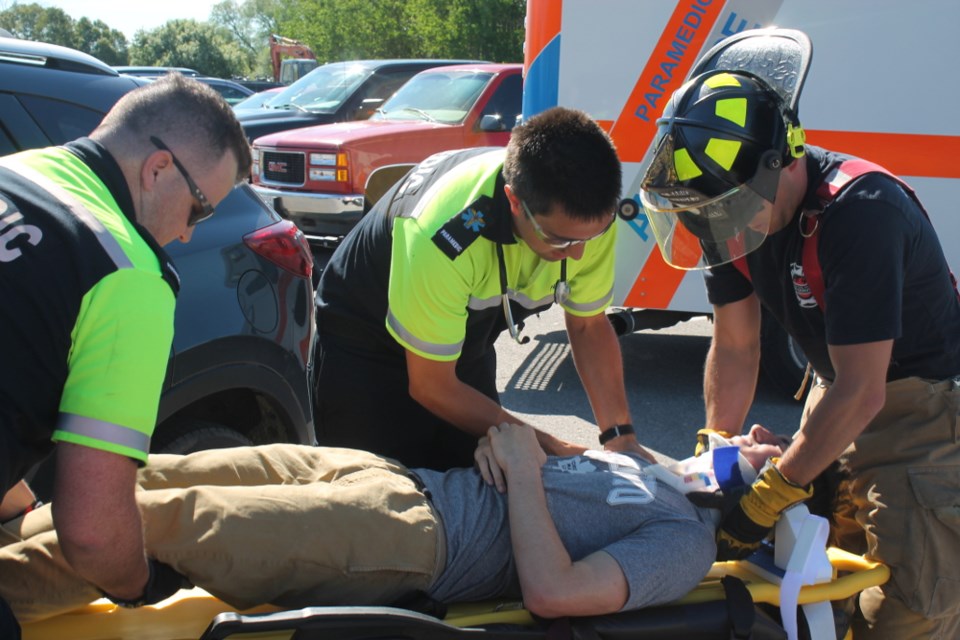Secondary school students at Korah Collegiate Tuesday got a close up, simulated look at what can happen if they drive dangerously.
Sault EMS paramedics, firefighters and Sault Area Hospital emergency room staff presented a number of mock scenarios in which young people are seriously injured and rushed to hospital after being involved in a motor vehicle crash while driving drunk, high or distracted.
Student volunteers acted as injured drivers, while Sault Fire Services demonstrated how they must often cut through mangled metal and use the jaws of life to extricate injured young drivers.
“It scares you, because you don’t want it to happen to you or anyone you love or anyone on the road, but it was good to see because in a situation like that you’re panicking, so it’s great to see what goes on and they (the paramedics) did a good job…responsibility is a major factor in this,” said Haarani Babu, a Grade 10 student at Korah, speaking to SooToday.
“I would insist if I were at a party there is a designated driver…and be very cautious of the hazards of other people on the road,” said Jordan Grondin, also a Korah Grade 10 student.
“This is preventable. This is something we can absolutely change,” said Anne Marie Hayes, Teens Learn to Drive president, speaking to Korah’s students.
Teens Learn to Drive is a Toronto-based, not-for-profit group dedicated to educating teens about the risks of dangerous driving, currently on a tour of northern Ontario and spending this week at each of the Sault’s high schools, with the help of several local sponsors and the provincial government.
The tour is called the Sweet Life Road Show.
“Every youth is entitled to a sweet, good, long life and the number one thing that’s likely to change that is if they are involved in a crash,” Hayes said.
“The impact (of a death or serious injury) on a school community is devastating.”
“Sadly, it’s not getting better, the numbers are starting to go up, and one of the reasons is definitely distracted driving,” Hayes told SooToday.
Students at Korah were divided into groups and rotated to several brief information sessions, each of them addressing a specific aspect of risky driving, before witnessing the emergency scenario in Korah Collegiate’s parking lot.
A funeral home hearse was also present, to ram home the point that life is sweet but can be cut short through dangerous driving.
“It’s not just ‘don’t drink and drive,’ because youth know that, they get that, they’re very good at designated drivers,” Hayes said.
“What they don’t get is that on their 19th birthday, they may be out drinking and they have to go to school or work the next morning. Do they know how long it takes for the alcohol to get out of their system? In some cases it may be 24 to 36 hours,” Hayes said.
The Teens Learn to Drive distracted driving information table spoke of ‘brain games.’
“We can’t really do two thinking things at once. When you’re driving, it’s a thinking task. When you’re texting or carrying on a conversation on a cell phone, that’s a thinking task, we can’t do two at once.”
What of marijuana and driving, a serious question since the federal government is determined to legalize the substance by July 1, 2018?
“A lot of youth have told me ‘I’m a better driver when I’m high because I’m sharper and more focused,’” Hayes said.
“In fact, when they’re high they lose short term memory, it impairs perception so you don’t recognize an obstacle right away, it takes longer to make a choice, it takes longer to react, and all of those things combined make it very dangerous for driving,” Hayes said.
Then there is pedestrian safety.
“More and more pedestrians are being hit by cars,” Hayes said, due to pedestrians texting and walking in front of vehicles, or being hit by distracted drivers.
“Many teens wear jeans and dark hoodies making them very hard to see at night so we talk to them about wearing contrasting colours and reflective surfaces so they can be seen at night.”
Another information session spoke of the dangers of falling asleep at the wheel through drowsy driving after a long day.
A caffeinated beverage such as coffee or a soft drink for an extremely tired driver, followed by a 20-minute nap (set your cell phone alarm), will allow a driver to become invigorated and alert enough to drive for another hour, Hayes said.
“It works unbelievably well, and that 20 minutes is important. If you sleep too long you go back into a drowsy cycle.”
Other risks addressed included passenger safety, such as passenger(s) urging a speeding driver to stop for a snack, a washroom break, “anything to change that situation,” Hayes said.
Sault Ste. Marie Police Service officers were also on hand to remind students seat belts are a must, both legally and for their own safety.
“It can be the biggest mistake in your life (causing an accident through careless driving, injuring yourself or others),” said Constable Alison Kirkpatrick.
